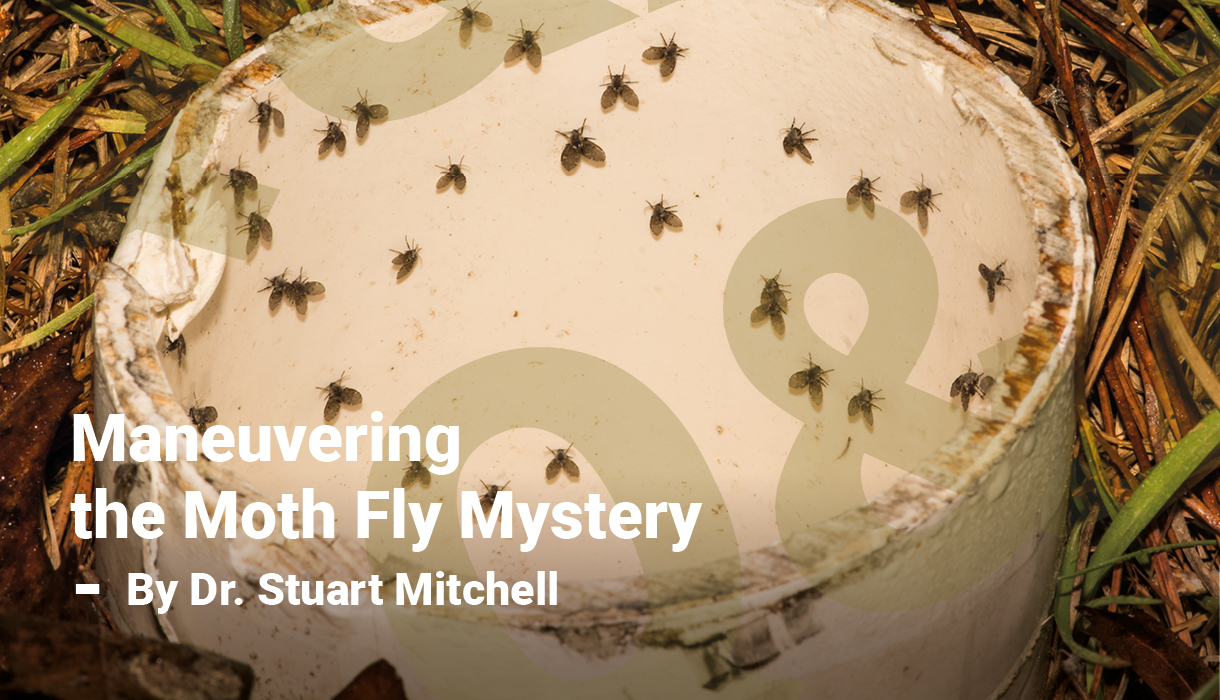Moth fly, scientifically known as Telmatoscopus albipunctatus (meaning “spotted white one watches standing water”), offers an intriguing discovery of biology and behavior. Ubiquitously pesky, questions arise regarding how to manage cryptic Moth fly populations and potential impacts on human health. To maneuver the Moth fly mystery, let’s delve into the details by answering a few common questions.
What is a Moth fly?
With wings “roof-like,” this filthy fly possesses a distinct moth-like appearance. Adult flies are 1/16-3/16” long, brownish or blackish in color, scaley, fuzzy, and fragile. Adult fly antennae possess 14 segments and are hairy in appearance. Notably, wings possess white spots at the edges and approximately 8 veins (two are forked) running parallel to the front edges (no cross veins).
In 1 to 4 weeks, Moth flies undergo complete metamorphosis or egg, larva (maggot), pupa, and adult. Living a few days to weeks, adult Moth flies are short-lived.
Adults are poor, juddering fliers over short distances. Sometimes, adults are observed walking on vertical surfaces.
Do Moth flies bite?
Moth flies cannot bite or sting. However, adult fly presence can be a significant annoyance.
Are Moth flies harmful?
Moth flies may be deemed potentially harmful in specific situations. They have the potential to transport pathogens from unsanitary areas directly to food. Additionally, inhaled Moth fly fragments may exacerbate asthma symptoms.
Where do Moth flies come from?
Moth flies flourish in filthy, damp conditions. Resource sites include filthy floor drains, unsanitary sewer, septic, and sump failures, gooey gutters, stagnate storm drains, contaminated cooling towers, rotten rain barrels, repulsive refuse containers, disgusting dumpsters, wretched wet organic material, and many other putrid possibilities.
With favorable winds, en masse adult Moth fly flushes may originate from nearby sewage treatment plants.
Are Moth flies attracted to light?
Adult Moth flies demonstrate an attraction to light. Placing a few at floor level, installing numerous UVA light traps can serve as an effective measure for monitoring and controlling these filthy flies.
How to get rid of Moth fly larvae?
Adult female Moth flies place numerous eggs on and in viscous biofilms. An unsanitary biofilm is a resilient and complex microbial community attached to a surface and enclosed within a protective matrix.
Moth fly larvae are tubular in shape and 1/8-3/8″ long. Breathing with extended aquatic spiracles, larvae and pupae live within biofilm. Although no easy task, reducing Moth fly larvae requires the reduction or elimination of biofilm resource sites.
Resource cleaning with beneficial bacteria significantly reduces resource site biofilms. This cleaning process works by introducing beneficial bacteria that break down, reduce, and eliminate organic materials containing biofilms.
Bacterial cleaners outcompete and eliminate biofilms through enzymatic kinetics or rapid breakdown of organic matter. Additionally, beneficial bacteria consume breakdown products, disrupt biofilm structures, and change the local environment to discourage biofilm formation. Continuous binary fission action and an eco-friendly profile make bacterial cleaners an attractive option for outcompeting and controlling biofilms.
How to get rid of Moth flies?
- Requires an integrated approach of sanitation, maintenance, and best practices
- Control weedy areas surrounding structures
- Adjust sprinkler systems away from structures
- Routinely clean gutters
- Maintain dumpsters in good condition (ensure cleanliness, serviceability, and position 50 feet from the building)
- Ensure refuse is bagged in puncture and tear resistant trash bags
- Short-store trash bags within securely sealed containers
- Regularly perform camera inspections of roof vents linked to sewer or septic systems
- Promptly repair any broken sewer lines and remove contaminated soil
- Routinely clean floor drains.
- Seal cracks in walls and floors
- Install air curtains to create positive pressure at service and overhead doors
- Install walk-by-monitoring devices to detect cryptically low-level Moth fly activity
- Strategic low-high placement of numerous light traps
- Light traps attract Moth flies using LED and/or fluorescent UVA light (capturing adult flies and preventing reproduction plays a significant role in population monitoring and control)
Understanding the disgusting derivation of messy Moth flies enables specific strategies to control their prolifically cryptic populations. For more help in maneuvering the Moth fly mystery, reach out to PestWest at 941.358.1983 or drop a line at customerservice@pestwest.com.





